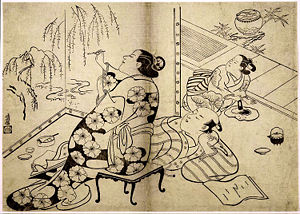CZ:Featured article/Current: Difference between revisions
Jump to navigation
Jump to search
imported>Chunbum Park (→Iraq War, major combat phase: Keynesians) |
imported>Chunbum Park |
||
| Line 1: | Line 1: | ||
== '''[[ | == '''[[Ukiyo-e]]''' == | ||
---- | ---- | ||
'''Ukiyo-e''' (浮世絵 ''ukiyoe'') is a form of [[Japan]]ese visual [[art]], both with its own intrinsic beauty, but also reflecting social systems of the Tokugawa or [[Edo Period]]s (1615-1868). It also extended artistic technique, including the printing of art books to make it more accessible to the wealthy, but socially inferior, merchant class. <ref name=LC>{{citation | |||
| url = http://www.loc.gov/exhibits/ukiyo-e/intro.html | |||
| title = The Floating World of Ukiyo-e: Shadows, Dreams, and Substance | |||
| publisher = [[Library of Congress]]}}</ref> | |||
[[Image:Courtesan painting a screen.jpg|left|300px|Courtesan painting a screen, Torii Kiyonobu I, ca. 1711]] | |||
Literally, ''ukiyo-e'' means pictures of the Floating World, which included both [[geisha]] and respected [[courtesan]]s, two quite distinct classes. It was a world of socially acceptable hedonism. | |||
''[[ | ''[[Ukiyo-e|.... (read more)]]'' | ||
{| class="wikitable collapsible collapsed" style="width: 90%; float: center; margin: 0.5em 1em 0.8em 0px;" | {| class="wikitable collapsible collapsed" style="width: 90%; float: center; margin: 0.5em 1em 0.8em 0px;" | ||
|- | |- | ||
! style="text-align: center;" | [[ | ! style="text-align: center;" | [[Ukiyo-e#References|notes]] | ||
|- | |- | ||
| | | | ||
{{reflist|2}} | {{reflist|2}} | ||
|} | |} | ||
Revision as of 17:57, 27 October 2013
Ukiyo-e
Ukiyo-e (浮世絵 ukiyoe) is a form of Japanese visual art, both with its own intrinsic beauty, but also reflecting social systems of the Tokugawa or Edo Periods (1615-1868). It also extended artistic technique, including the printing of art books to make it more accessible to the wealthy, but socially inferior, merchant class. [1]
Literally, ukiyo-e means pictures of the Floating World, which included both geisha and respected courtesans, two quite distinct classes. It was a world of socially acceptable hedonism.
| notes |
|---|
